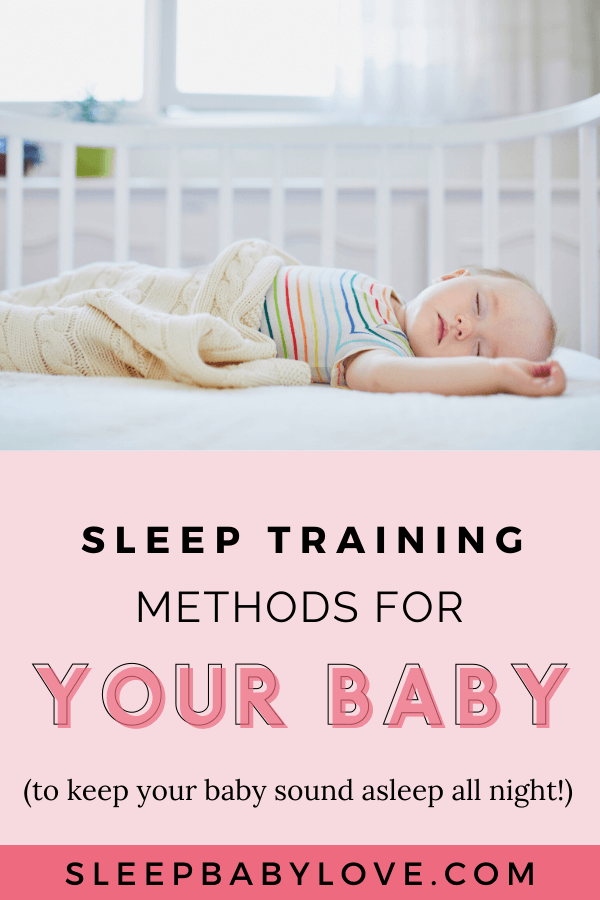Which Sleep Training Method Is Best?
There is a good chance that you found this article when searching the internet (very possibly at 2 am) saying “I need more sleep!” You may have heard about sleep training but you probably aren’t sure which sleep training method is best. Or, maybe you’ll just settle for your sweet little baby to stop waking on the hour, every hour. Or maybe you just feel awful that you’re making every mistake in the book.
Let’s break it down for ya, shall we?
What is sleep training?
If you’re not sure why your cute baby is waking up more and more and sleeping less and less, there is a good chance your baby doesn’t know how to fall asleep independently causing infant sleep problems
Does your baby know how to fall asleep independently?
Falling asleep independently is a skill and some babies naturally have the skill and some don’t. When your baby requires you to help them fall asleep (and stay asleep), your baby has a sleep association.
You can’t expect your baby to fall back asleep in the middle of the night when your baby doesn’t know how to go to sleep. You’ll know your baby is ready for sleep training when your baby is up many times a night or takes short naps.
You’ll know when you are ready (or after 4 months of age).
Sleep Associations Include:
- Rocking
- Bouncing
- Shushing, Patting, Swaying
- Car-ing (let’s pretend that’s a word)
- Feeding to Sleep (Boob or Bottle)
- Pacifier (this one isn’t necessarily a bad sleep association, just depends)
Plus, …a million other ways that something is getting your baby to fall asleep.
Despite your best attempts to instill positive sleep habits from birth, things just didn’t go your way. If your baby doesn’t know how to fall asleep right now, have no fear! You can teach your baby this skill. Yes, teach.
Teaching your baby to fall asleep independently is called sleep training.
Ok, so now you know that you know what sleep training is, you may be wondering, how the heck should I get my baby to fall asleep?
To teach your baby to fall asleep independently, you need a solid plan. Not a “let’s just try and pray” plan but a sleep training plan to take any uncertainty out of the situation.
A large component of your sleep plan is coming up with a soothing method. Figuring out getting rid of night feedings to get your baby to sleep through the night and figuring out a plan to lengthen short naps are also very important.
Sleep Training Methods Explained
After a solid bedtime routine, you will put your baby in the crib (drowsy but awake is fine to start but for a baby older than 6 months, you will want your baby to be more awake then drowsy).
Once your baby is set into the crib awake, you will confidently leave the room.
Now, here’s where the magic happens. Your baby says “thanks mom and dad, I’ve been wanting to fall asleep on my own for some time”. And, he rolls over and goes to sleep. The END.
Oh, I wish it would go like that.
Most likely, your baby will starts crying.
Your baby is crying not because he doesn’t love you. It’s because this is new. He doesn’t have the skills to fall asleep.
So this is when we use our sleep training method.
4 Different Sleep Training Methods To Choose From
Picking a method is all about your comfort level and how much you would like to be involved in the process.
Sure – the internet may give you more methods to choose from but I like to keep things simple and four methods are plenty to get you started. (I know you are tired, you do not need any more reading.)
You have to pick a method and stick with it.
Pick Up / Put Down Method:
This method has the most parental involvement. You will be reassuring your baby the entire time.
This is a great method for a younger baby (and you can even start this method before you are even sleep training – but just trying to improve sleep.)
The Chair Method
I also consider the chair method a gentler sleep training method. Although your baby still may be crying during this method, you can be confident knowing you will be in your baby’s presence the entire time.
Your presence “through sitting in the chair”, moves away from your baby (also called “fading”) as she learns to fall asleep independently.
The chair method is an approach I recommend for an older baby (approx 12 months through preschooler). The reason I don’t recommend it for a younger baby is that it can be stimulating and difficult to have your baby nearby without picking her up.
Some of my clients love the chair method and feel good about using it since they think it will be the easiest since you will be in your child’s presence.
Other clients (including me!) think it will be very difficult to sit through your child’s cries.
What do you think?
How to do the Chair Method:
Step 1: After a solid bedtime routine, put your baby awake in the crib. Walk out of the room confidently. Once your baby starts to cry re-enter your baby’s room and this time bring a chair to sit in.
Pssst… I recommend using a different chair than a glider that is already in the room? Why? Because a different chair is a symbol for sleep but also a glider can’t be moved easily to different positions. Grab a folding chair or a dining room chair!
Step 2: If your baby is upset, go back to your room and bring a chair with you to sit in. Sit in said chair.
Step 3: You can use words, or touch but try and keep your baby in the crib the entire time. Less is always more when touching your child but there are no hard and fast rules the first couple nights.
Step 4: Your baby will fall asleep in your presence but will fall asleep independently.
Step 5: Leave the room and celebrate (without waking up your baby).
Every time your baby wakes up, resume your spot in the chair and repeat the process over and over.
Every three days move the chair further and further from your baby’s crib to wean your presence over time. This method usually takes about 14 days until you’re out of your baby’s room.
Controlled Comforting:
Controlled comforting is when you are checking on your child the entire time while he is learning how to fall asleep independently. You will be in and out of the room in between the check methods.
Controlled comforting can also be called check and console or you may be more familiar with the Ferber method (thanks to Dr. Ferber and his book).
How to the Controlled Comforting Method
Whatever you want to call this method, the premise is similar. Over set intervals of time, you go back in and comfort your baby. I suggest that you can shush, pat, touch and use comforting words, but you do it for only 1 minute and your goal is not to calm your baby down.
There are two rules that I’m a stickler about while using this method:
Your goal is to reassure your baby (and yourself)
You are NOT to pick your baby out of the crib (that’s very stimulating)
You are NOT trying to calm your baby during a check time.
In my sleep practice, the majority of my clients start with this method since I’m all about finding something that parents can be consistent with. This is the method that most parents feel like they can stick to.
If you find that your baby gets riled up during a check, you may not be a good fit to use this method.
Extinction:
The extinction method I consider as “cry-it-out”. You choose not to respond to your child when they are learning this important skill.
How to do the Extinction Method
Extinction is when you leave your baby to “work it out” on their own. You won’t soothe, sit or pick up your baby. You will say “night night” and let your baby learn to fall asleep independently.
I know, leaving your baby to cry sounds controversial and the internet loves to tell you that this method is going to break your baby. But, extinction works when parents are ready to commit.
(Please don’t be a hater and tell me I’m horrible about talking it – Can’t we just all get along?)
When using extinction, your baby gets a very clear message, unlike some of the methods above.
Very few of my clients choose this method when they are starting to sleep train for the first time. So start where you feel comfortable and decide what works for your family and baby.
Which Sleep Training Method is Best?
I get a lot of questions about sleep training. The million-dollar question I often get is which sleep training method is best? You’re probably not going to like my answer.
The sleep training method that is best is the one that you can stick to!
All sleep training methods listed above can work. They really can.
But, you need a solid plan and you have to be prepared. And the soothing method is only a small part of the overall plan!
Don’t worry – I got your back if you want to learn more about sleep training. Check out the ultimate guide to sleep training
Conclusion
All sleep training soothing methods can work as long as you are prepared. Choosing a method that works for you is just one component of creating a sleep training plan. But getting ready is half the battle and hopefully, you have the clarity to pick one (and solve sleep challenges once and for all!)

